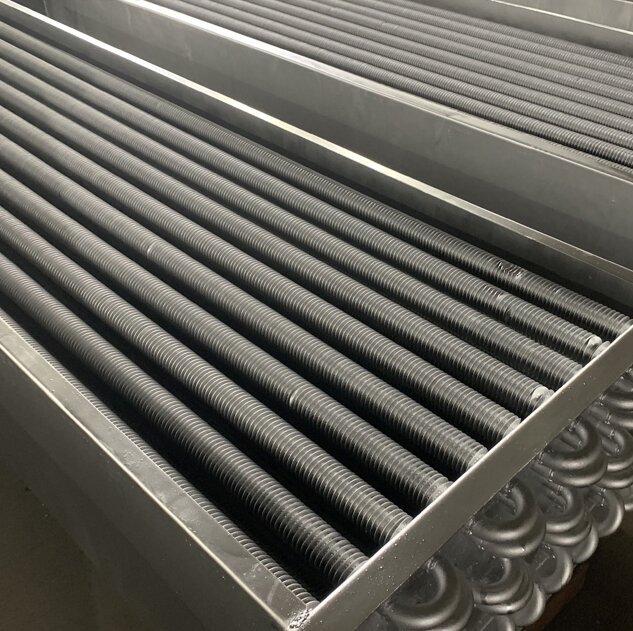How to optimize design of finned tube heat exchangers?
As an important component of heat exchange equipment, the design optimization of finned tube heat exchangers is crucial for improving heat transfer efficiency. The following will discuss in detail how to optimize the design of finned tube heat exchangers to improve heat transfer efficiency from the aspects of fin structure, material selection, flow characteristics, and operation control.
1、 Optimization of fin structure in finned tube heat exchanger
The fin structure of a finned tube heat exchanger is its core part, which directly determines the heat transfer efficiency. To improve heat transfer efficiency, the fin structure can be optimized from the following aspects:
Optimization of fin shape:
Traditional fin shapes are mostly flat, but in recent years, new types of fin shapes such as corrugated and spiral have gradually received attention. These new fin shapes can increase the contact area between the fluid and the fins, improving thermal conductivity efficiency. In addition, by changing parameters such as the height, width, and spacing of the fins, the shape of the fins can be further optimized to meet different operating conditions.
Optimization of the number and arrangement of fins:
Increasing the number of fins or changing the arrangement of fins can increase the heat transfer area and improve heat transfer efficiency. However, it should be noted that an excessive number of fins will increase the resistance to fluid flow and reduce the overall performance of the heat exchanger. Therefore, when optimizing the number and arrangement of fins, it is necessary to comprehensively consider factors such as heat transfer efficiency, flow resistance, and manufacturing cost.
2、 Selection of materials for finned tube heat exchangers
The selection of materials has a significant impact on the heat transfer efficiency of finned tube heat exchangers. Here are some suggestions for optimizing material selection:
Choose materials with high thermal conductivity:
Materials with high thermal conductivity can accelerate heat transfer and improve heat transfer efficiency. For example, metal materials such as aluminum alloy and copper have high thermal conductivity and are ideal choices for finned tube heat exchangers.
Considering the corrosion resistance and high temperature resistance of materials:
Finned tube heat exchangers typically operate in harsh environments such as high temperature, high pressure, corrosive media, etc. Therefore, when selecting materials, it is necessary to consider their corrosion resistance and high temperature resistance to ensure that finned tube heat exchangers can maintain stable performance in long-term use.
3、 Optimization of flow characteristics of finned tube heat exchanger
Flow characteristics are one of the key factors affecting the heat transfer efficiency of finned tube heat exchangers. Here are some methods to optimize flow characteristics:
Optimizing fluid flow state:
The flow state of the fluid directly determines the heat transfer effect. By adjusting the inlet and outlet positions, optimizing the fin layout, and other methods, the flow state of fluid between fins can be improved, making it more uniform and stable. This can improve heat transfer efficiency and reduce energy consumption.
Reduce pressure drop:
Pressure drop is an important indicator of the flow characteristics of finned tube heat exchangers. By reducing the spacing between fins and optimizing the shape of fins, pressure drop and fluid flow resistance can be reduced. This can not only improve heat exchange efficiency, but also reduce the operating costs of the equipment.
4、 Optimization of operation control of finned tube heat exchanger
Operation control is a key link to ensure the efficient operation of finned tube heat exchangers. Some methods for optimizing operational control:
Optimize fluid flow and temperature control:
Adjust fluid flow and temperature according to actual needs to avoid energy waste caused by excessive or insufficient flow. At the same time, an intelligent temperature control system is adopted to automatically adjust the working temperature of the finned tube according to the ambient temperature and heat exchange requirements, achieving efficient energy utilization.
Introducing enhanced heat transfer technology:
Introducing enhanced heat transfer technology in finned tube heat exchangers, such as adding longitudinal or transverse differential elements, increasing fluid jet impingement, vortex flow, etc., can increase the turbulence level of the fluid and improve heat transfer efficiency.
By optimizing the fin structure, material selection, flow characteristics, and operational control, the heat transfer efficiency of finned tube heat exchangers can be significantly improved. In practical applications, it is necessary to select appropriate optimization methods based on specific working conditions and requirements to achieve the best heat exchange effect.


